Asian Longhorned Tick

Name of Tick: Asian longhorned tick
Danger Level: Extreme
Nicknames: longhorned tick, bush tick, cattle tick, Asian tick, clone tick
Scientific Name of Tick: Haemaphysalis longicornis
Habitat: Heavily distributed in East and Southern Asia, New Zealand, Fiji, and Australia. Populations of this tick in the United States are still being determined, the Asian longhorned tick is an emerging threat to the mainland. The Asian longhorned tick has been found in more than a half dozen states along the eastern seaboard.
Specific Habitat: The Asian longhorned tick has a diverse range of habitat. They live in wooded areas and forests, on the sides of trails and in grasslands, in brushy areas, in medium and short grass. The Asian longhorned tick has also been found on freshly mowed lawns in urban areas. Areas inhabited by cattle are at high risk for infestation from the Asian longhorned tick.
Tick Facts and Information: The Asian longhorned tick has three life stages, larvae, nymph, and adult. Larvae are most aggressive in late summer; they can remain attached and feeding on a victim for several days. Nymphs will attack in the spring, adult Asian longhorned ticks most often hunt during in the summer months. Both nymphs and adults can remain attached to a blood host for 3 or more days. Adult Asian longhorned ticks can live up to a year or longer without a blood host. Female adult Asian longhorned ticks can produce eggs on their own, without mating, in large numbers, this capability to asexually reproduce has experts concerned about this tick’s potential to wreak havoc in the United States. A single adult female Asian longhorned tick can lay 2000 eggs. In parts of Asia the Asian longhorned tick has decimated the cattle industry. The Asian longhorned tick hunts by questing. A bite from an infected Asian longhorned tick can debilitating disease and result in death.
Tick Color and Appearance: Adult female Asian longhorned ticks have a burnt brown or reddish caramel color, solid, smooth and even color scheme across the whole tick.
Size and Number of Legs: The average adult Asian longhorned tick is 1/8 of an inch, size will vary greatly during the tick’s life cycle. Larvae have 6 legs, nymphs and adults have 8 legs.
Sicknesses and Diseases Transmitted: Lyme disease, spotted fever, Russian spring-summer encephalitis, Powassan virus, Khasan virus, tick-borne encephalitis virus, severe fever with thrombocytopenia syndrome, babesiosis
Control Solution: Tick Proof Repellent
Full Scientific Classification: Kingdom: Animalia, Phylum: Arthropoda, Class: Arachnida, Subclass: Acari, Order: Ixodida, Family: Ixodidae, Genus: Haemaphysalis, Species: H. longicornis
